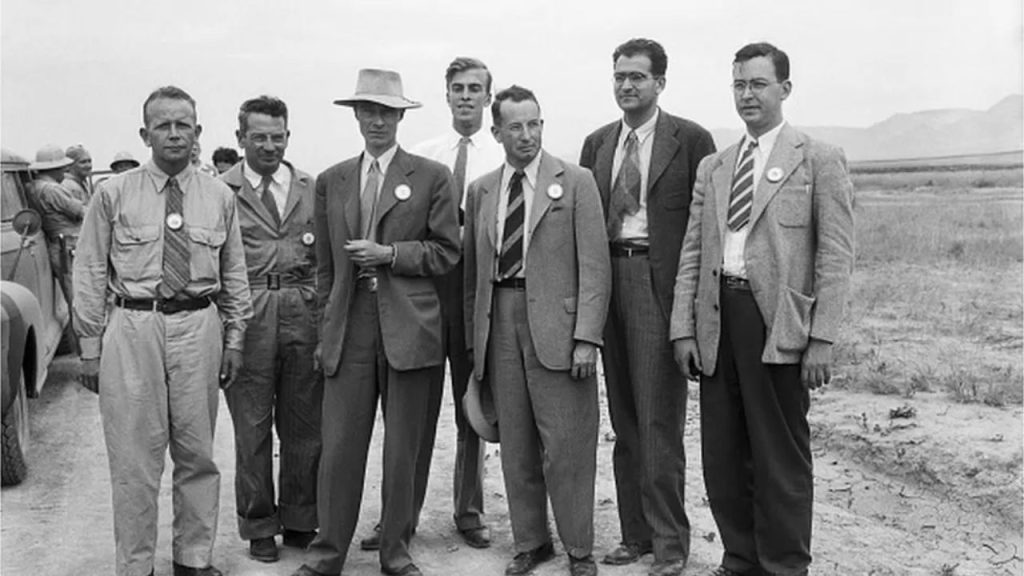Oppenheimer, the latest biographical thriller directed by Christopher Nolan, explores the complex life of J. Robert Oppenheimer, often referred to as the “father of the atomic bomb.” The film has received widespread acclaim globally, including in India, where it has become a box office hit. However, a particular scene portraying Oppenheimer reading the Bhagavad Gita, one of Hinduism’s holiest texts, after an intimate moment, has sparked controversy and protests in certain quarters.

The film captures a pivotal moment in history: July 1945, two days before the detonation of the first atomic bomb in the New Mexico desert. In this tense period, Oppenheimer, a theoretical physicist, recites a stanza from the Bhagavad Gita, also known as The Lord’s Song. This choice to incorporate the sacred Hindu scripture into the narrative reflects Oppenheimer’s personal connection to the text and its influence on him during significant moments of his life.
The roots of Oppenheimer’s fascination with Sanskrit and the Bhagavad Gita trace back to his time as a young professor in Berkeley. Arthur W. Ryder, a professor of Sanskrit at the University of California, Berkeley, introduced the precocious physicist to the ancient Indian language. This marked the beginning of Oppenheimer’s journey into the world of Sanskrit, a language that would become a lifelong passion.
In their authoritative 2005 biography, American Prometheus: The Triumph and Tragedy of J. Robert Oppenheimer, Kai Bird and Martin J. Sherwin shed light on Oppenheimer’s early encounters with Ryder. A young Oppenheimer, only 25 at the time, arrived at Berkeley as an assistant professor. Over the following decades, he played a crucial role in building one of the “greatest schools of theoretical physics” in the United States.
Ryder, described as a Republican and a “sharp-tongued iconoclast,” found Oppenheimer fascinating. Oppenheimer reciprocated this sentiment, regarding Ryder as a “quintessential intellectual.” According to Oppenheimer, Ryder embodied stoicism in his feelings, thoughts, and conversations. This sentiment was echoed by Oppenheimer’s father, who saw Ryder as a “remarkable combination of austereness through which peeps the gentlest soul.”
The biographers note that Ryder played a pivotal role in Oppenheimer’s initiation into Sanskrit. Ryder, an unconventional and intellectually stimulating figure, began giving Oppenheimer private lessons in Sanskrit on Thursday evenings. Oppenheimer, in a letter to his brother Frank, expressed his joy in learning Sanskrit, describing it as a “sweet luxury” to be taught.

However, Oppenheimer’s newfound passion for an Indian language raised eyebrows among some of his friends, including Harold F. Cherniss, who introduced Oppenheimer to Ryder. Despite the skepticism, Cherniss believed that Oppenheimer’s interest in Sanskrit made “perfect sense” given his inclination towards the mystical and cryptic.
Oppenheimer’s proficiency in languages extended beyond Sanskrit. He had previously studied Greek, Latin, French, and German and even learned Dutch in a remarkably short period. This linguistic prowess allowed him to delve into the Bhagavad Gita, which he found “very easy and quite marvelous.” Oppenheimer’s admiration for the Gita was such that he considered it the “most beautiful philosophical song existing in any known tongue.”
The Meghaduta, a lyric poem written by Kalidasa, one of the greatest poets in Sanskrit, was among Oppenheimer’s favorite texts. He shared his delight in reading the Meghaduta with Ryder and expressed enchantment with the poem’s beauty.
In 1933, Oppenheimer’s father gifted him a Chrysler, and in a symbolic gesture, Oppenheimer named it Garuda, after the giant bird God in Hindu mythology. This reflected the scientist’s deep immersion in his Sanskrit studies and his connection to Indian culture.
Oppenheimer’s philosophical outlook was shaped by his engagement with eastern philosophy, as evidenced in a letter to his brother in the spring of 1933. In the letter, he emphasized the importance of discipline in achieving serenity and freedom from the distractions of personal desire. He drew on eastern philosophy, particularly the Gita, to navigate the complexities of existence.
During the late twenties, Oppenheimer sought earthly detachment, not to escape to a purely spiritual realm but to find peace of mind. The Gita, with its notions of karma, destiny, and earthly duty, provided the philosophical framework that resonated with Oppenheimer’s intellectual sensibilities. His biographers speculate that Oppenheimer’s attraction to the fatalism of the Gita may have been a rebellion against the teachings of his youth, referencing his early association with the Ethical Culture Society.
Oppenheimer was not alone in his admiration for the Bhagavad Gita. Notable figures like Henry David Thoreau, Heinrich Himmler, Mahatma Gandhi, WB Yeats, and TS Eliot also found inspiration in its profound teachings. The Gita’s impact on Oppenheimer’s life became especially evident after the detonation of the first atomic bomb.
The image of the giant orange mushroom cloud rising in the sky prompted Oppenheimer to revisit the Bhagavad Gita. He famously quoted a verse from the Gita in a 1965 documentary, saying, “Now I am become Death, the destroyer of worlds.” This line resonates with the scripture’s portrayal of Vishnu taking on a multi-armed form to persuade a prince to fulfill his duty. Oppenheimer’s reflection on the destructive power of the atomic bomb drew parallels with the Gita’s profound philosophy.

Despite the monumental consequences of the atomic bombings on Hiroshima and Nagasaki during World War II, Oppenheimer’s connection to the Bhagavad Gita persisted. He acknowledged the irrevocable change brought about by the atomic bomb, quoting the Gita to convey the weight of the moment. Some dismissed this quote as one of Oppenheimer’s “priestly exaggerations,” but its significance in understanding his mindset cannot be overlooked.
When asked by The Christian Century about the books that most profoundly influenced his philosophical outlook, Oppenheimer placed Baudelaire’s Les Fleurs du Mal in the top spot, followed by the Bhagavad Gita. This underscores the enduring impact of Eastern philosophy on Oppenheimer’s intellectual journey.
The controversy surrounding the depiction of Oppenheimer reading the Bhagavad Gita in the film has sparked objections from some right-wing Hindus, particularly regarding a scene involving Oppenheimer and his lover. Despite these protests, Indian film censors have found no issue with the portrayal, and the movie continues to dominate the box office in India, surpassing even blockbuster films like Barbie.
In conclusion, Oppenheimer’s connection to Sanskrit and the Bhagavad Gita is a crucial aspect of understanding his intellectual and philosophical journey. The film, despite its controversy, brings attention to Oppenheimer’s complex relationship with Eastern philosophy and how it influenced his perspectives on science, humanity, and the profound consequences of his work on the atomic bomb.












